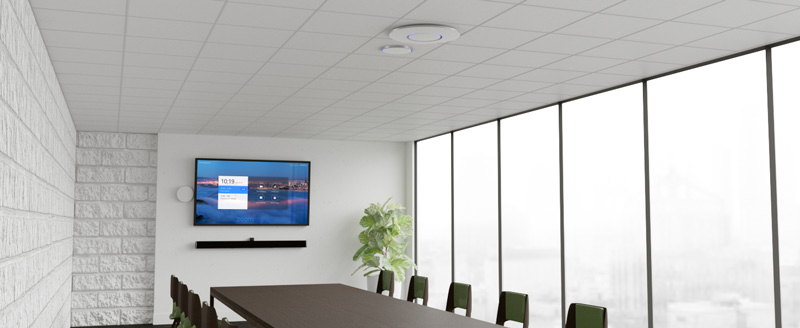Picking the right microphone for your hybrid workplace is an essential part of conference room audio. The process involves a delicate balance, considering various crucial factors to ensure pristine audio for virtual participants. These considerations encompass room dimensions, attendee count, visual aesthetics, and the unique dynamics of your hybrid environment.
The right microphone solution not only ensures crystal-clear sound transmission but also contributes to a seamless, engaging meeting experience that transcends physical boundaries. In this blog post, we delve into the diverse range of audio options, shedding light on their merits and limitations, and guiding you toward the perfect audio setup that aligns seamlessly with your hybrid conferencing goals.
A conference table microphone is a type of microphone specifically designed to pick up speech from multiple participants around a conference table. These microphones can come in various forms and designs, but they share the goal of ensuring clear audio pickup in meeting and conference settings
Advantages
Disadvantages
Characteristics and Features
Multiple Pickup Patterns: Many conference table microphones are omnidirectional, which means they can pick up sound equally from all directions. However, some might have a cardioid or supercardioid pickup pattern to focus on specific areas of the table.
Daisy-Chain Capabilities: Some conference microphones can be connected in a series (daisy-chained) so that multiple mics can be used to cover a large conference table, ensuring all participants are clearly heard.
Noise and Echo Cancellation: Modern conference microphones often include technologies to reduce background noise and echo, ensuring clear communication especially during video or teleconferencing.
Integrated Speakers: Some models include built-in speakers, providing an all-in-one solution for both audio input and output in a conference setting.
Portability: Many conference microphones are designed to be portable and easy to set up, making them ideal for temporary setups or traveling.
Connectivity: These microphones can come with various connectivity options, including USB, Bluetooth, or traditional XLR and ¼” jack connectors, to interface with different conferencing systems.
Application Uses
Consider a business boardroom setting where there are 10 participants seated around a long table. In such a scenario, using just one microphone at the end of the table wouldn’t effectively pick up everyone, especially those seated far from the mic. By placing several conference table microphones at regular intervals down the length of the table, or by using a single, centrally located omnidirectional microphone, all participants can be clearly heard.
A ceiling microphone is a microphone that’s designed to be mounted on or suspended from a ceiling, typically for the purpose of picking up audio in a room without taking up desk or floor space. These are commonly used in boardrooms, conference rooms, classrooms, and other spaces where it’s desirable to have a more unobtrusive microphone setup or where table space is at a premium.
Advantages
Disadvantages
Characteristics and Features
Wide Area Coverage: Ceiling microphones are designed to pick up audio from a larger area, ensuring everyone in the room is heard. Some are equipped with multiple mic capsules or elements to cover various zones in the room.
Unobtrusive: By being mounted on the ceiling, these mics reduce clutter on tables or floors and are less obtrusive in the field of view, especially during video conferences.
Advanced DSP: Many ceiling microphones are designed to work with digital signal processors (DSPs) to provide features like automatic mixing, noise reduction, and echo cancellation. This ensures clear audio pickup and delivery, especially in rooms with challenging acoustics.
Beamforming Technology: Some advanced ceiling microphones use beamforming technology, which allows the microphone to focus its pickup pattern towards the sound source (like a person speaking) and minimize background noise. This is especially useful in larger rooms where there can be multiple sources of sound.
Integrated Amplification: Some models come with built-in amplification or provide the ability to connect directly to speakers or a PA system.
Scalability: In larger rooms or spaces, multiple ceiling microphones can be used in tandem to ensure full coverage.
Application Uses
Imagine a modern corporate boardroom equipped for video conferencing. To avoid cables running across the table and to ensure an unobstructed view of all participants, the organization chooses to install ceiling microphones. This way, every participant, whether seated or standing, can be heard clearly during a conference call without any obtrusive equipment in the visual frame.

The audio setup for your conference room hinges on a blend of technology choices, be it boundary, beamforming, or others. When deciding between table mics, ceiling mics, or a hybrid approach, it’s vital that your audiovisual integrator possesses a comprehensive understanding of your company, the specific room, other systems within the space, and a myriad of factors influencing the ideal audio solution.
Engage actively with your AV service provider. Pose questions and seek insights. They appreciate such interactions as it helps them tailor solutions that best suit your needs.
As a refresher, consider the following questions:
Remember, the right questions lead to the right solutions. Make sure you’re equipped to ask them.
Send us a message today to set up a free consultation. Our team of audiovisual engineers will help you outfit your collaboration space to meet the needs of the modern workplace.